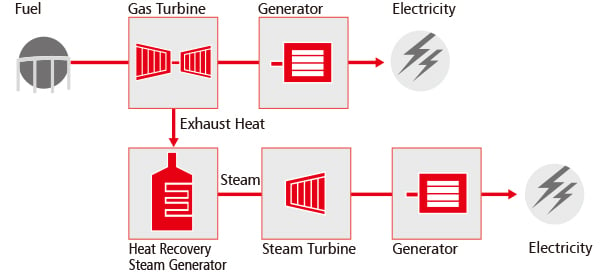Gas Turbine Combined Cycle (GTCC) Power Plants

-
World-class Power Generation Efficiency
At Least 64% (LHV)
-
Wide Output Range
30 to 1332 MW Class
-
Combined Cycle Power Plants
On Grid Facility for Verification Testing
-
CO2 Emissions Compared with Those of Conventional Coal-fired Thermal Power Generation
About 65% Lower
High efficiency energy through combined cycle power generation
Gas turbine combined cycle (GTCC) power plants use natural gas to deliver the cleanest and highest efficiency power generation.
Plants employing state-of-the-art JAC-series gas turbines of Mitsubishi Power have a 20% higher power generation efficiency than conventional coal-fired thermal power generation systems and the world’s highest level of efficiency of more than 64%. That enables CO2 emissions an approximate 65% reduction.
What is GTCC?
In the power generation method characterized by the standalone operation of a gas turbine, known as the simple or open cycle, releases exhaust gas at temperatures of around 600℃ into the atmosphere.
Combined cycle power generation improves the general thermal efficiency of the plant by recovering this high temperature exhaust gas. Many combined cycle power generation plants adopt a waste heat recovery cycle in which exhaust gas from the gas turbine is led to the waste heat recovery boiler to generate steam using recovered heat to drive the steam turbine.

Advantages and Features that Make the GTCC the Mainstream for New Thermal Power Generation Facilities
- High level of thermal efficiency
- In comparison with thermal efficiency of about 40% in steam power generation, combined cycle power generation features a thermal efficiency of at least 60% (with both figures on the lower heating value basis).
- Environmentally-friendly
- Carbon dioxide (CO2) is released in smaller quantities into the atmosphere.
- Nitrogen oxides (NOx) and sulfur oxides (SOx) are released in smaller quantities into the atmosphere.
- High temperature wastewater is discharged in smaller quantities into the sea.
Our GTCC Business
In 1984, we delivered a combined cycle power plant to the Higashi-Niigata Thermal Power Station of Tohoku Electric Power Co., Inc. to achieve a revolutionary thermal efficiency over 44%, then the world' s highest. It attained far greater energy efficiency than conventional thermal power plants.
In 1999, a combined cycle power plant incorporating the G-series gas turbine was constructed and delivered for the No. 4 Series for the same power station. The thermal efficiency of the plant exceeded 50%. In 2018, the combined cycle power plant with the J-series gas turbine reached a cumulative total operation time of 600,000 hours as a commercial system. A cumulative total operation time of more than 600,000 hours is a yardstick for the reliability of gas turbines in the power generation industry.
As Japan' s one and only manufacturer engaging in design, manufacturing, civil engineering, installation, commissioning and after-sales services with its own technologies, we proudly hold a great track record.
For overseas markets, we have exported the combined cycle power plants to about 20 countries mainly in Southeast Asia, the Middle East, Europe, North America and South America.
Products
- GTCC
- Steam Power
- IGCC
- Geothermal
-
Gas Turbines
- Product Lineup
- Comparative Performance
-
Technical Information
- Gas Turbines for Mechanical Drive Applications
- Cutting-Edge Elemental Technology Producing 1600°C Class J Gas Turbines
- Development of High-Efficiency Gas Turbine Applying 1600°C Class J Technology
- Combustor Technologies Supporting Stable Operation
- Overview and Verification Status of T-Point 2 Demonstration Facility
- Comprehensive Efforts from Development to Manufacturing
- Summary of Orders
- Development History
- Product Selection Assistant (Middle & small Class)
- Aero-derivative Gas Turbines
- Steam Turbines
- Boilers
- Air Quality Control Systems (AQCS)
- Generators
-
Control Systems
- What is DIASYS?
- DIASYS Netmation
-
DIASYS Optional Products
- IR-S Infrared Flame Detector
- Net IR-S Infrared Flame Detector
- Rail Mounting Net IR-S
- Boiler Tube Leak Detector
- Shaft Vibration Analyzer
- Simulator
- Advanced Combustion Pressure Fluctuation Monitoring System (A-CPFM) / Combustion Pressure Fluctuation Monitoring System (CPFM)
- Multi-Coal Fired Boiler Optimum Control
- FXtoLS Adapter
- Fuel Cells
- Additive Manufacturing
- Catalogue
- HIACS Series
- Technical Report
test